Kayaker Chris Korbulic as he films an expedition for the South American paddling show Kaiak.
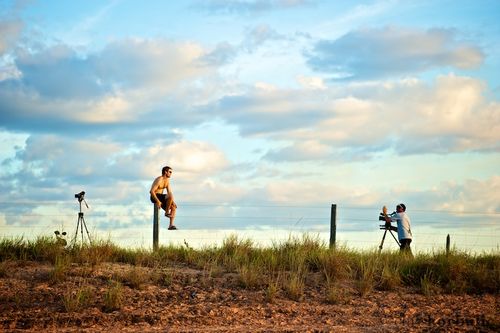
The road to Boa Vista was dry. The trees were covered with dust, the sky ahead was clear, and the air around us stole the moisture from our skin. No sign of rain in the near future, only the suspicion that we might be going the wrong way. A phone call telling us about massive rains and high water where we had just come from did little to ease our doubts. We were going full speed into the next leg of the trip, and as much as it sounds like a joke, if you get four Brazilians loaded with cameras moving that fast during Carnaval, you don’t want to take the chance of slowing down, much less turning around.
We knew this part of the country was going to be relatively dry, so we aimed for bigger rivers. They should always have enough water to mitigate any problems with water levels. Another problem presented itself here, though, when we heard that we weren’t allowed through the local municipality to our entry point on the Rio Mau. It forms the border between Brazil and Guyana, and federal police and local government have become weary of foreigners in the region because of an ongoing drug trade and a recent film crew's misrepresentation of their actions. Indigenous peoples living along the rivers have become weary of foreigners after years of mining exploitation and attempts at hydro development. They have shut down multiple attempts at establishing hydro projects. Neither side was about to let the three of us traverse this touchy border-forming river, alone, on whatever “adventure” we were trying to explain. After a few meetings and two days of waiting for word, they said we could enter the following week on the premise that we bring 80 liters of diesel, make loads of deliveries, and bring a local guide down the river to survey past mining projects. This was no small price, but also an opportunity to aid the local community and change the peoples perception of foreigners, if only for a few days. Bring a local down in an inflatable as well? What could possibly go wrong?
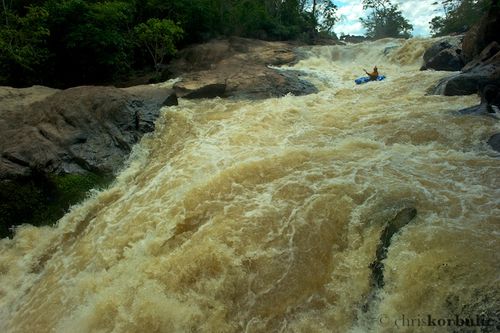
����������������������������������������������������������������������
In the meantime, we faced a plethora of choices, and while group decision-making is usually a difficult, drawn-out affair, we were somehow on the same page: Guyana and Kaietuer Falls. It was going to have to be a blitz on Guyana, and it seemed like a preposterous idea. Laughable. We had five days to get to Kaietuer Falls, descend 50 km of the Rio Potaro below the falls, and somehow make it back to Roraima and the Rio Mau to make our deliveries on time. This was our open door, and we had to go through. The opportunity to go paddle in Guyana and Kaietuer Falls National Park could not be missed, as there has been little to no paddling done in Guyana, also known as the Land of Many Waters. A national park would usually cause us concern about permission, but park officials gave us the green light before we even got on the plane, as long as we promised not to go over the falls. The access problems we might encounter fo many of Guyana's rivers would be similar to the difficulties we faced in Brazil. Indigenous lands and federally protected areas cover much of the Guyana Shield, helping to hold off development and preserve the environment.
Guyana, the poorest country in South America, is reputed in Brazil to be a dangerous destination. We were warned with wagging fingers and shaking heads, and we saw much of the same once we reached Georgetown, Guyana; but here they were fingers and hands in the air and heads bouncing to reggae beats. Fortunately we spent little time in the surprisingly bustling city before flying from the Guyana coast over some of the most untouched jungle in the world on the way to Kaieteur Falls, the largest waterfall on earth, by height and volume.
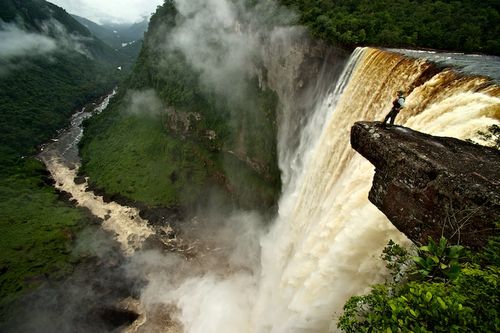
There's a diving board of rock next to the falls. You can look just past your toes, 740 feet to the pool at the bottom, where water and air explode back up 100 feet before blasting across the pool like a hurricane. Standing at the edge, my stomach jumped, and I felt the almost overwhelming urge to jump. It's a terrifying place to love, but letting your shoulders slide over the edge is a feeling unmatched anywhere. The venue was unbelievable, the view unmatched. Sitting on the edge, the sound from the base of the falls was muffled—barely reaching our perch.
A local Amerindian brought us down the trail to the river where we could try to access the base of the falls. “It's a two day trip to reach up there. No trail, very steep, and full of danger,” he told us. “Today, no. You need more time.”
It was just before noon, and we figured we could paddle upstream to cut down on walking time, using our usual means to access difficult places such as these. We paddled as much as we could, but were stopped by rapids over and over and were forced to leave our boats behind. We considered turning back, but brief, obscured views of the top of the falls kept us on the trail until just before dark.
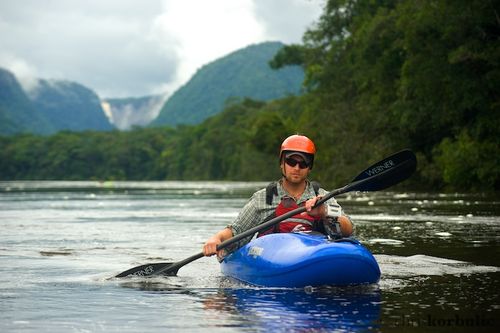
“Two day trip” kept ringing in my head, but once we reached the first open view of the falls, the bass and rhythm of the falls was all I heard. Paradise is where you make it, and I was ready to lay some roots on the bare rock with an open view of the falls. Twenty minutes and some laughs later, it was back on the trail to our boats and camp. Twenty minutes again and it was total darkness. New moon, heavy clouds, rain, deep jungle, and our headlamps. Paradise that night was a small, dry, overhung rock along the trail. I woke sporadically to stare out at the dark jungle and soon I was watching the silhouette of leaves in the morning light, marking the start of another long day.
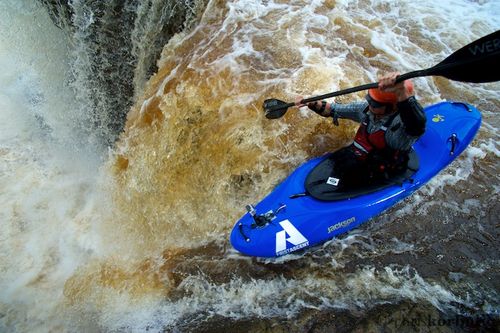
Morning had come surprisingly quickly, and our kayaks were just around the corner. I thought I knew what to expect in the gorge, but to find myself paddling through it was worth every minute in sweaty, speeding, public transport, and—on the trail—every slip and sting. The wilderness surrounding the falls is one of the largest intact tracts of rainforest in the world, and we entered the Rio Potaro's VIP room when we started paddling below the falls. Clouds hung low in the gorge, mist and condensation shining in the overcast light. Every corner was overhung with trees straining to reach sunlight, and Kaietuer Falls upstream would peak out over the canopy occasionally, kilometer after kilometer. The full river coaxed us downstream and out of the gorge, dropping us at another falls, Amatok, and a small village with a couple motor boats sitting in the eddy. I wasn't sure if I should be excited about the boats, especially because they were little bigger than our own kayaks. Only one had a functional motor, and it was questionable whether it would work. The Amatok villagers use the river as transport to work at mines downstream. They took us in—their first visitors in a year—with aplomb, sharing stories, juice, and crackers until they found a good motor to put on a boat for us. They wondered how the world outside their paradise was doing, but only slightly. There's no reason, really, when what you want and what you need are the same.
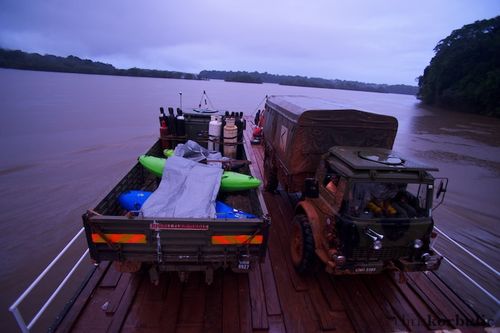
The small boat brought us about the same distance it took us all day to paddle, and dropped us at a small mining landing just after dark. There was a small bar and not much else. We drove through an area that looked like something from the California gold rush; small, rough towns brimming with tough-looking miners walking down streets where music boomed through swinging bar doors. Later, we laid flat on wooden benches for the first time in two days at a closed ferry crossing. After a few hours of sleep, we were on the road again, which brought us back to Boa Vista in Brazil. We were hoping to find another open door to another river. We had passed a moment that had the potential to stop the mission in its tracks the last time in Boa Vista, and we were welcomed with another logistical roadblock. Not even all the diesel in the world was going to get us in, but a detour to southern Venezuela could do the trick for us in the meantime.
–Chris Korbulic